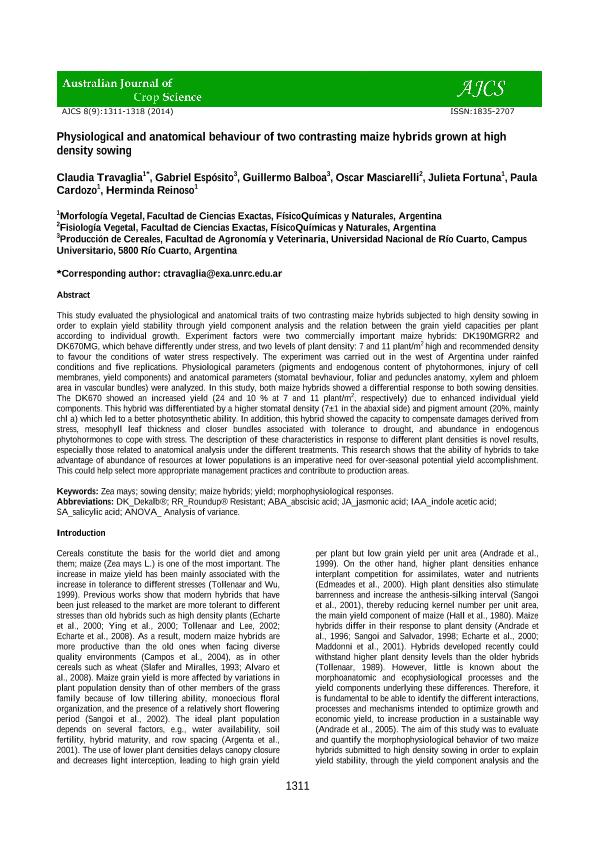Mostrar el registro sencillo del ítem
dc.contributor.author
Travaglia, Claudia Noemi

dc.contributor.author
Espósito, Gabriel Pablo

dc.contributor.author
Balboa, Guillermo Raul

dc.contributor.author
Masciarelli, Oscar Alberto

dc.contributor.author
Fortuna, Julieta Belén

dc.contributor.author
Cardozo, Paula Gabriela

dc.contributor.author
Reinoso, Herminda Elmira

dc.date.available
2018-04-23T17:01:02Z
dc.date.issued
2014-09
dc.identifier.citation
Travaglia, Claudia Noemi; Espósito, Gabriel Pablo; Balboa, Guillermo Raul; Masciarelli, Oscar Alberto; Fortuna, Julieta Belén; et al.; Morphophysiological behaviour and performance of modern maize hybrids grown at different plant densities; Southern Cross Publishing; Australian Journal of Crop Science; 8; 9; 9-2014; 1311-1318
dc.identifier.issn
1835-2693
dc.identifier.uri
http://hdl.handle.net/11336/43032
dc.description.abstract
This study evaluated the physiological and anatomical traits of two contrasting maize hybrids subjected to high density sowing in order to explain yield stability through yield component analysis and the relation between the grain yield capacities per plant according to individual growth. Experiment factors were two commercially important maize hybrids: DK190MGRR2 and DK670MG, which behave differently under stress, and two levels of plant density: 7 and 11 plant/m2 high and recommended density to favour the conditions of water stress respectively. The experiment was carried out in the west of Argentina under rainfed conditions and five replications. Physiological parameters (pigments and endogenous content of phytohormones, injury of cell membranes, yield components) and anatomical parameters (stomatal bevhaviour, foliar and peduncles anatomy, xylem and phloem area in vascular bundles) were analyzed. In this study, both maize hybrids showed a differential response to both sowing densities. The DK670 showed an increased yield (24 and 10 % at 7 and 11 plant/m2 , respectively) due to enhanced individual yield components. This hybrid was differentiated by a higher stomatal density (7±1 in the abaxial side) and pigment amount (20%, mainly chl a) which led to a better photosynthetic ability. In addition, this hybrid showed the capacity to compensate damages derived from stress, mesophyll leaf thickness and closer bundles associated with tolerance to drought, and abundance in endogenous phytohormones to cope with stress. The description of these characteristics in response to different plant densities is novel results, especially those related to anatomical analysis under the different treatments. This research shows that the ability of hybrids to take advantage of abundance of resources at lower populations is an imperative need for over-seasonal potential yield accomplishment. This could help select more appropriate management practices and contribute to production areas.
dc.format
application/pdf
dc.language.iso
eng
dc.publisher
Southern Cross Publishing

dc.rights
info:eu-repo/semantics/openAccess
dc.rights.uri
https://creativecommons.org/licenses/by-nc-sa/2.5/ar/
dc.subject
Zea Mays
dc.subject
Sowing Density
dc.subject
Maize Hybrids
dc.subject
Yield
dc.subject
Morphophysiological Responses
dc.subject.classification
Agricultura

dc.subject.classification
Agricultura, Silvicultura y Pesca

dc.subject.classification
CIENCIAS AGRÍCOLAS

dc.title
Morphophysiological behaviour and performance of modern maize hybrids grown at different plant densities
dc.type
info:eu-repo/semantics/article
dc.type
info:ar-repo/semantics/artículo
dc.type
info:eu-repo/semantics/publishedVersion
dc.date.updated
2018-01-29T19:45:18Z
dc.identifier.eissn
1835-2707
dc.journal.volume
8
dc.journal.number
9
dc.journal.pagination
1311-1318
dc.journal.pais
Australia

dc.description.fil
Fil: Travaglia, Claudia Noemi. Consejo Nacional de Investigaciones Científicas y Técnicas; Argentina. Universidad Nacional de Río Cuarto. Facultad de Ciencias Exactas Fisicoquímicas y Naturales; Argentina
dc.description.fil
Fil: Espósito, Gabriel Pablo. Universidad Nacional de Río Cuarto. Facultad de Agronomía y Veterinaria; Argentina
dc.description.fil
Fil: Balboa, Guillermo Raul. Universidad Nacional de Río Cuarto. Facultad de Agronomía y Veterinaria; Argentina
dc.description.fil
Fil: Masciarelli, Oscar Alberto. Consejo Nacional de Investigaciones Científicas y Técnicas; Argentina. Universidad Nacional de Río Cuarto. Facultad de Ciencias Exactas Fisicoquímicas y Naturales; Argentina
dc.description.fil
Fil: Fortuna, Julieta Belén. Universidad Nacional de Río Cuarto. Facultad de Ciencias Exactas Fisicoquímicas y Naturales; Argentina
dc.description.fil
Fil: Cardozo, Paula Gabriela. Consejo Nacional de Investigaciones Científicas y Técnicas; Argentina. Universidad Nacional de Río Cuarto. Facultad de Ciencias Exactas Fisicoquímicas y Naturales; Argentina
dc.description.fil
Fil: Reinoso, Herminda Elmira. Universidad Nacional de Río Cuarto. Facultad de Ciencias Exactas Fisicoquímicas y Naturales; Argentina
dc.journal.title
Australian Journal of Crop Science

dc.relation.alternativeid
info:eu-repo/semantics/altIdentifier/url/http://www.cropj.com/september2014.html
dc.relation.alternativeid
info:eu-repo/semantics/altIdentifier/url/http://www.cropj.com/travaglia_8_9_2014_1311_1318.pdf
Archivos asociados
